Annual State of NHSScotland Assets and Facilities Report for 2013
A review of asset and facilities management performance in NHSScotland, identifying the current state of the estate and facilities management, highlighting areas of best practice and areas for improvement.
5.0 Performance
This section of the report reviews asset and facilities services performance across NHSScotland with the aim of gaining an insight into where opportunities lie for improving performance.
5.1 The National Asset and Facilities Performance Framework
The National Asset and Facilities Performance Framework provides an essential link between asset and facilities services performance and patient needs as defined in the NHSScotland Quality Strategy's three Quality Ambitions. Since introducing the Performance Framework in the 2011 State of the NHSScotland Estate Report further work has been undertaken to align the Framework with the outcome measures for the Quality Strategy developed by the NHSScotland Quality Measures Technical Group. The diagram below shows the relationship between the Quality Strategy and the National Asset and Facilities Services Performance Framework.
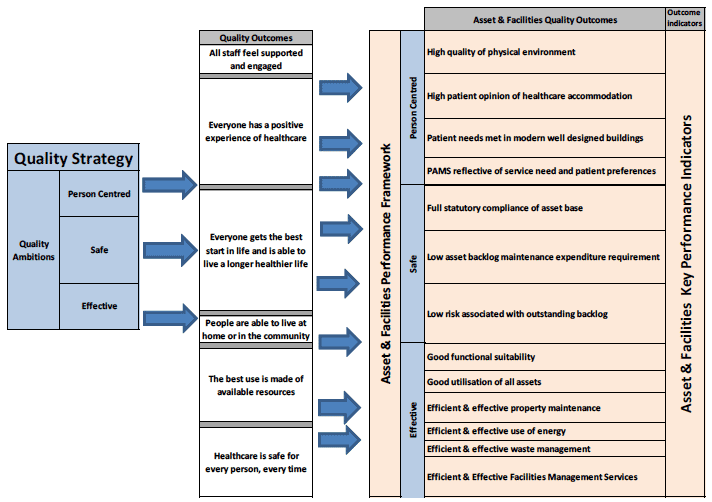
The Framework provides targets for improvement in asset and facilities services performance by 2020 and uses 23 key performance indicators to monitor year on year progress towards the achievement of these targets. It should be noted that the 2020 Performance Targets are (a) provisional and subject to review to reflect the outcome of the work on the 2020 Visioning, and (b) based on the qualification that their attainment will not reduce service quality. Broadly, half of the KPIs are based on quality measures and half are based on cost measures. The National Asset and Facilities Performance Framework for 2013 is shown below.
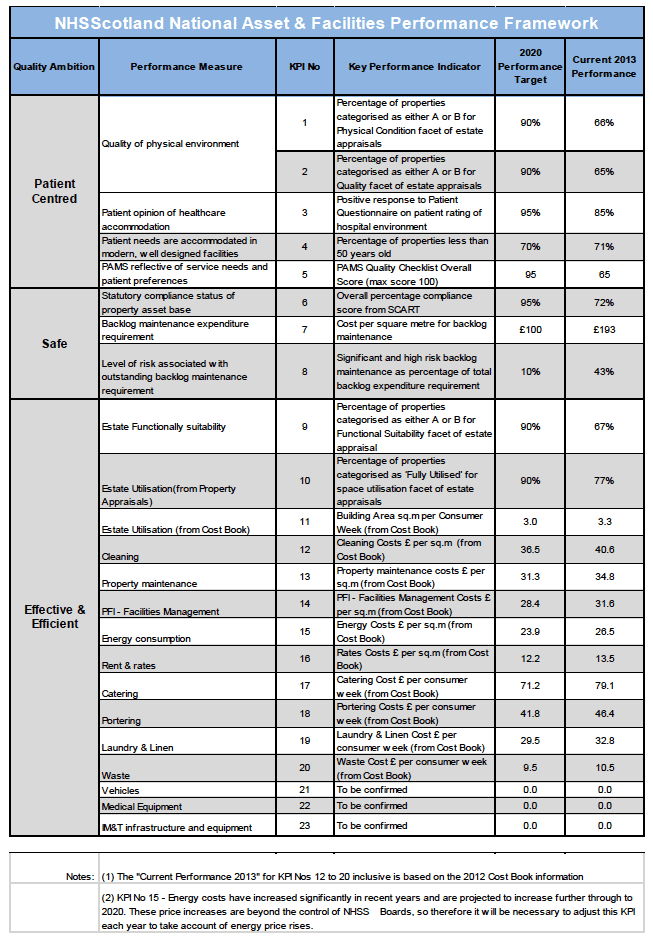
A separate Performance Framework has now been developed for office accommodation and the current results for 2013 are included in Section 5.2.
5.1.1 Change in Framework KPIs - 2012 to 2013
A key objective of this report is to monitor year on year change in asset and facilities services performance to ensure that NHSScotland is progressing towards achievement of the 2020 targets in the National Asset Performance Framework. The table below shows the performance change between 2012 and 2013.
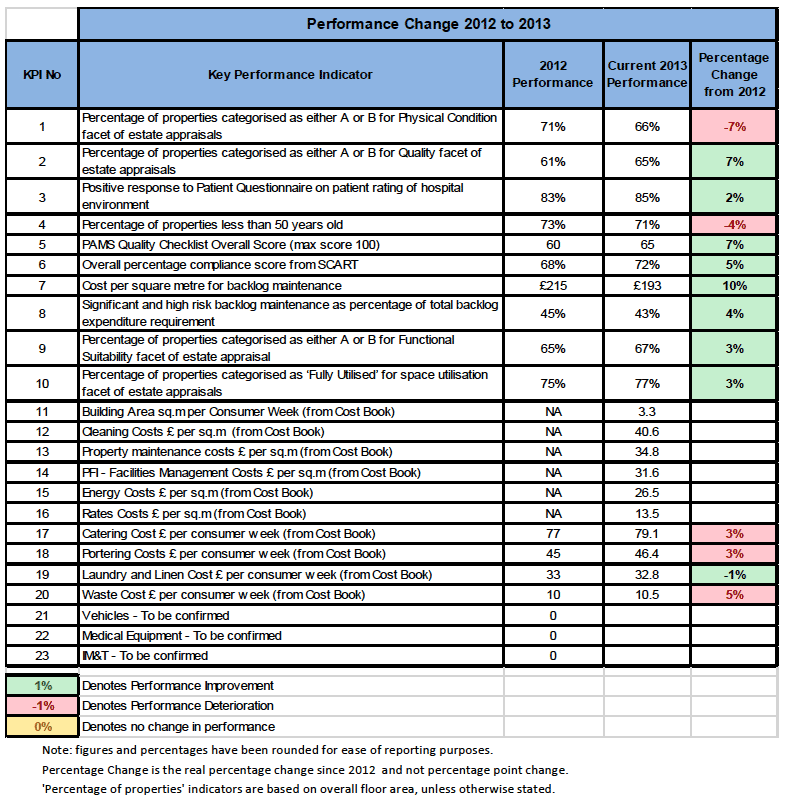
Note: figures and percentages have been rounded for ease of reporting purposes.
Percentage Change is the real percentage change since 2012 and not percentage point change.
'Percentage of properties' indicators are based on overall floor area, unless otherwise stated.
5.1.2 Changes in National Asset Performance Framework KPIs
The following provides an overview of performance change between 2011 (when the performance framework was first developed) and 2013, along with a short commentary on the changes.
KPI Nos 1 to 10 - Derived from property appraisal information and PAMS provided by Boards
(Note: 'Percentage of properties' indicators are based on overall floor area, unless otherwise stated).
Physical Condition
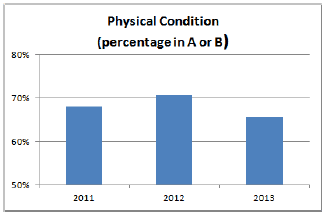
Physical condition of the estate has fluctuated over the last 3 years between 66% and 71% in condition A or B. Completion of new facilities such as Forth Valley Royal Hospital and the new State Hospital have helped to improve overall condition but this is counteracted with new surveys that have identified further deterioration of the existing estate since their last survey. 20% of NHS Board's property assets were re-surveyed in 2012/13.
NHS Boards' estates in the worst overall condition are actively planning improvements to overcome this problem. This includes:
- NHS Dumfries & Galloway is planning an ambitious change programme based around the re-provision of its acute hospital.
- NHS Grampian has plans to invest directly in the reduction of backlog maintenance as well as rationalise its redundant properties.
- NHS Highland is planning to redevelop Argyll & Bute Hospital and Raigmore Hospital, and to replace Bandenoch & Strathspey Hospital, Skye Hospital, and Bedford Hospital.
- NHS Orkney is planning to replace its hospital and main primary care centre, which accounts for over 50% of its estate.
Quality
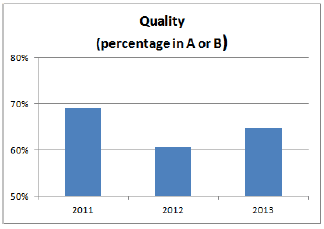
This indicator is influenced by other indicators such as the quality of the internal environment, physical condition and functional suitability. It is a relatively new indicator which has taken time to be adopted across NHSScotland's estate, hence the 2013 indicator of 65% in A or B for Quality is perhaps a more accurate reflection than previous years. It also appears more aligned to the physical condition KPI.
Patient Rating of the Hospital Environment
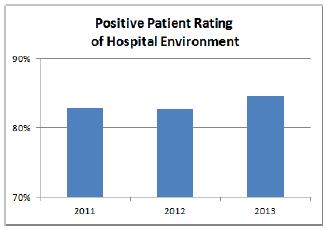
This is the sole indicator taken from NHSScotland's patient questionnaire survey and has recently seen a 2 percentage point improvement in the patient's opinion on the hospital environment, with a positive rating now above 84%.
Properties less than 50 Years Old
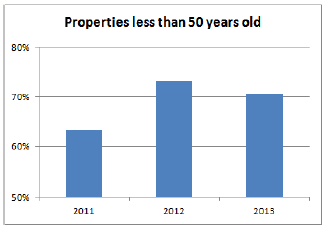
This indicator highlights the challenge faced by NHSScotland in that whilst there continues to be significant investment made in its property assets there has been a drop in 2013 in the proportion of the estate less than 50 years old. Over 1.25m sq.m of NHS Board accommodation is now over 50 years old.
NHS Boards with a larger proportion of their estate over 50 years old are making the following plans to address this challenge:
- Completion of NHS Greater Glasgow & Clyde's New South Glasgow Hospitals project will replace 243,000sq.m of older estate with new, modern facilities.
- NHS Lothian are embarking on several replacement programmes including a new Royal Hospital for Sick Children.
- NHS Grampian's disposal strategy will remove some of its older properties.
- NHS Shetland are working on a medium to long term plan for the Acute hospital estate
PAMS Quality Checklist Overall Score (max score 100)
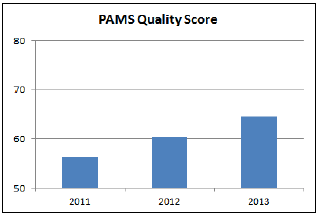
NHS Boards have steadily improved the quality and content of their Property & Asset Management Strategies and now, in general, provide a clearer link between their Boards' clinical strategy and their investment plans necessary to bring about service change and improvement. These results are also influenced by a more challenging assessment process which focuses on continued improvement in the strategic planning of all of NHSScotland's assets.
Overall percentage compliance score from SCART
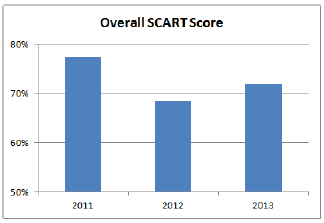
SCART is a self-assessment tool that indicates general compliance with policies and procedures related to property aspects of statutory compliance. While there has been an improvement in score between 2012 and 2013 it is still below the 2011 score. The main reason appears to be that initially assessments in 2011 concentrated on high priority areas, such as inpatient accommodation, whereas, as further assessments have covered the remaining estate more non-compliance issues have been identified.
Backlog Maintenance Cost per sq.m.
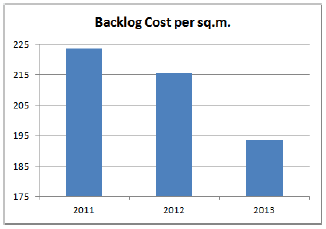
This is an important, positive indicator of the impact of focussed attention on backlog maintenance since 2011 and represents a £145m reduction in backlog for NHS Boards (data excludes Special NHS Boards).
Whilst some of this is due to the substantial re-survey work commissioned by HFS, it is also due to direct investment in rectification of backlog maintenance, as well as the rationalisation of redundant properties following completion of new investment projects.
Further improvements in this indicator are expected as continued investment is carried out on the ageing & poor condition parts of the overall estate (as described above).
Proportion of Significant & High Risk Backlog Maintenance
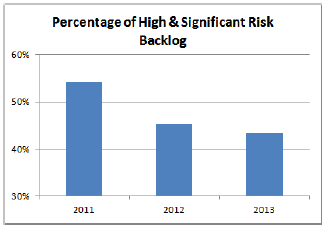
This indicator confirms that the investment in reducing backlog described above has been focussed on the most important higher risk backlog maintenance items. This is shown by the annual reduction in significant and high risk backlog since 2011.
Functional Suitability
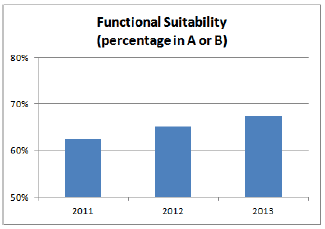
There has been a steady improvement in the functional suitability of healthcare estate since 2011 which is due both as a result of new investments replacing outdated accommodation, as well as the substantial re-appraisal of this indicator across NHSScotland's estate.
Investments planned for NHS Boards most affected by functional suitability problems, such as NHS Greater Glasgow & Clyde, NHS Dumfries & Galloway and NHS Orkney, will enable significant portions of NHSScotland's estate to provide more patient focussed, safe and functionally effective new accommodation.
Fully Utilised Space
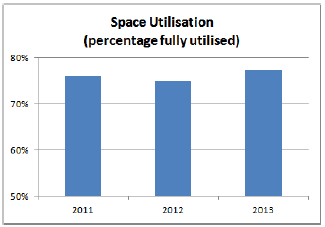
The proportion of the estate that is regarded as fully used has remained relatively constant at above 75% for the last 3 years.
This remains an ongoing concern as property space remains an expensive asset to maintain and operate and thus needs to be more effectively and fully utilised. At the same time, overcrowding affects operational efficiencies and thus needs to be planned out of available accommodation.
Boards will need to rigorously examine their current performance in relation to space utilisation since any space that is not fully utilised represents an opportunity to make better use of assets and improve efficiency.
| KPI Nos 11 to 20 - Cost Book Derived KPIs |
|
|---|---|
| Building area per consumer week |
As part of the measures to improve the quality and consistency of data, the unit of measurement for building size was changed from 100 cu.m to sq.m in the 2012 Cost Book. Therefore, no comparable KPIs are available for the previous years |
| Cleaning Costs £ per sq.m |
|
| Property maintenance costs £ per sq.m |
|
| PFI - Facilities Management Costs £ per sq.m |
|
| Energy Costs £ per sq.m |
|
| Rates Costs £ per sq.m |
|
| Catering Cost £/consumer week |
Catering costs have increased by 1.4% over two years |
| Portering Costs £/consumer week |
Portering costs have increased by 10.5% over two years |
| Laundry & Linen Cost £/consumer week |
Laundry & linen costs have reduced by 2.5 % over two years |
| Waste Cost £/consumer week |
Waste costs have increased by 31% over two years |
The Strategic Review of Soft Facilities Management Services Programme is carrying out a strategic review of Soft FM services across NHSScotland to identify improvements and efficiencies that can be made to these services, and thus make improvements to the above performance KPI's.
5.1.3 Performance variation across Boards
Whilst the Performance Framework provides a useful "national picture" of performance on a range of asset and facilities management services, it does potentially mask variation in performance across Boards. Further analysis of the Performance Framework KPIs at Board level reveals significant variation across Boards as shown in the tables which follow, which compares each Board's performance on each of the 20 KPIs from the Performance Framework.
These tables are produced from information taken from the 2012 Cost Book and it should be recognised that detailed comparisons between NHS Boards based on the Cost Book should be treated with some caution because of the potential for different assumptions underpinning the calculations having been made. For example, NWTCB / Golden Jubilee is a singular specialist hospital which delivers high tech surgical services and therefore is not directly comparable to any other Board. Also, the cost per consumer week for smaller NHS Boards (particularly the Island Boards) can be affected by a lack of economies of scale and the requirement for a minimum level of infrastructure that supports a low level of patient activity (consumer weeks).
In response to the information contained within these tables, NHS Boards will need to develop an action plan to:
- Ensure that the cost, area and activity data used in the KPI's accurately reflects actual performance at hospital level.
- Understand the operational reasons for variation in performance at hospital level to identify where efficiencies can be made.
- Implement the outcomes from the Soft FM review.
| NHS Board |
Percentage of properties categorised as either A or B for Physical Condition |
Percentage of properties categorised as either A or B for Quality |
Positive response to Patient Questionnaire on patient rating of 'hospital environment' |
Percentage of properties less than 50 years old |
PAMS Quality Checklist Overall Score (%) |
Overall percentage compliance score from SCART |
Cost per square metre for backlog maintenance |
Percentage of significant and high risk backlog maintenance |
Percentage of properties categorised as either A or B for Functional Suitability |
Percentage of properties categorised as 'Fully Utilised' for space utilisation |
|---|---|---|---|---|---|---|---|---|---|---|
| NHS Greater Glasgow & Clyde |
77% |
45% |
75 |
71% |
72% |
64% |
134 |
30% |
50% |
73% |
| NHS Lothian |
58% |
81% |
83 |
49% |
83% |
76% |
148 |
84% |
82% |
79% |
| NHS Tayside |
59% |
91% |
85 |
72% |
50% |
37% |
100 |
53% |
80% |
87% |
| NHS Grampian |
47% |
68% |
83 |
61% |
81% |
55% |
379 |
33% |
64% |
78% |
| NHS Fife |
79% |
69% |
73 |
75% |
67% |
80% |
228 |
38% |
77% |
78% |
| NHS Ayrshire & Arran |
60% |
64% |
85 |
68% |
76% |
69% |
303 |
52% |
71% |
78% |
| NHS Lanarkshire |
72% |
63% |
71 |
89% |
71% |
86% |
222 |
49% |
63% |
88% |
| Highland |
32% |
40% |
90 |
97% |
61% |
57% |
364 |
36% |
71% |
58% |
| NHS Forth Valley |
81% |
81% |
73 |
92% |
72% |
68% |
67 |
12% |
84% |
95% |
| NHS Dumfries & Galloway |
55% |
49% |
86 |
66% |
62% |
71% |
427 |
47% |
54% |
45% |
| NHS Borders |
99% |
67% |
85 |
67% |
58% |
79% |
85 |
31% |
63% |
80% |
| NWTCB - Hospital |
91% |
93% |
98 |
100% |
22% |
86% |
40 |
8% |
93% |
98% |
| Western Isles |
94% |
98% |
94 |
90% |
63% |
95% |
72 |
41% |
95% |
81% |
| State Hospitals Board for Scotland |
100% |
100% |
n/a |
98% |
70% |
94% |
14 |
38% |
100% |
88% |
| NHS Shetland |
30% |
68% |
93 |
49% |
49% |
65% |
177 |
79% |
72% |
73% |
| NHS Orkney |
28% |
76% |
94 |
70% |
78% |
70% |
593 |
14% |
49% |
52% |
| NHS Board Average 2013: |
66% |
65% |
85 |
71% |
64.6% |
72% |
193 |
43% |
67% |
77% |
| Board |
Building Area sq.m per Consumer Week (from Cost Book) |
Cleaning Costs £ per sq.m (from Cost Book) |
Property maintenance costs £ per sq.m (from Cost Book) |
PFI - Facilities Management Costs £ per sq.m (from Cost Book) |
Energy Costs £ per sq.m (from Cost Book) |
Rates Costs £ per sq.m (from Cost Book) |
Catering Cost £ per consumer week (from Cost Book) |
Portering Costs £ per consumer week (from Cost Book) |
Laundry & Linen Cost £ per consumer week (from Cost Book) |
Waste Cost £ per consumer week (from Cost Book) |
Property & Facilities Management Services Cost £ per consumer week* |
|---|---|---|---|---|---|---|---|---|---|---|---|
| NHS Greater Glasgow |
3.4 |
40.9 |
28.7 |
33.1 |
25.9 |
12.1 |
70.9 |
55.4 |
29.5 |
11.1 |
648.1 |
| NHS Lanarkshire |
2.2 |
41.9 |
71.8 |
104.2 |
21.0 |
17.0 |
83.9 |
28.7 |
43.4 |
10.7 |
737.4 |
| NHS Tayside |
4.6 |
28.8 |
27.4 |
0.0 |
19.3 |
10.6 |
71.4 |
53.7 |
33.4 |
9.0 |
560.6 |
| NHS Dumfries & Galloway |
3.3 |
50.7 |
56.1 |
17.3 |
28.8 |
13.0 |
95.4 |
25.6 |
38.5 |
14.1 |
728.0 |
| NHS Ayrshire & Arran |
2.9 |
41.6 |
42.5 |
17.2 |
23.7 |
11.3 |
80.1 |
53.5 |
39.5 |
10.6 |
585.5 |
| NHS Grampian |
2.9 |
52.7 |
33.5 |
0.0 |
33.5 |
14.6 |
68.1 |
46.7 |
29.0 |
9.6 |
541.1 |
| NHS Lothian |
3.2 |
38.7 |
31.7 |
63.9 |
25.7 |
14.1 |
85.4 |
46.9 |
28.2 |
8.5 |
730.4 |
| NHS Fife |
3.6 |
34.3 |
20.8 |
44.6 |
18.4 |
10.1 |
72.1 |
41.6 |
29.5 |
8.7 |
612.5 |
| NHS Highland |
3.3 |
39.5 |
35.6 |
14.7 |
42.2 |
17.9 |
98.7 |
42.5 |
28.4 |
12.3 |
670.5 |
| NHS Borders |
2.9 |
50.6 |
46.6 |
0.0 |
26.0 |
15.4 |
81.4 |
18.8 |
39.8 |
0.0 |
538.4 |
| State Hospital |
3.3 |
63.1 |
33.5 |
0.0 |
36.0 |
17.3 |
111.9 |
13.2 |
6.7 |
4.9 |
637.4 |
| NHS Western Isles |
3.8 |
45.0 |
60.6 |
0.0 |
50.4 |
23.2 |
145.2 |
36.5 |
37.6 |
13.4 |
917.3 |
| Golden Jubilee |
5.7 |
23.0 |
51.8 |
0.0 |
48.0 |
28.3 |
145.2 |
55.6 |
52.8 |
32.2 |
1142.0 |
| NHS Orkney |
2.9 |
66.3 |
64.1 |
0.0 |
54.8 |
22.1 |
102.5 |
54.2 |
79.3 |
4.5 |
843.1 |
| NHS Shetland |
7.1 |
54.9 |
42.6 |
0.0 |
26.9 |
9.7 |
327.4 |
0.0** |
111.9 |
15.6 |
1410.1 |
| NHS Forth Valley |
3.2 |
46.1 |
37.4 |
29.3 |
33.6 |
20.5 |
79.7 |
41.2 |
39.3 |
18.7 |
711.5 |
* the final column combines the 10 Cost Book based KPIs in the Framework into a single composite KPI "Property and Facilities Management Services Cost", and relates to the £660 million expenditure on property and facilities services described in Section 3.1 of this report.
** Portering costs for NHS Shetland are included / absorbed within other cost categories.
5.1.4 Projected reduction in backlog maintenance expenditure requirement
In 2011, NHS Boards estimated that the then backlog maintenance expenditure requirement of £1,010 million would reduce significant over the next 5 year period as a result of the plans for:
- Direct expenditure on reducing high and significant backlog
- Rationalisation and disposal of older properties thereby avoiding the need for expenditure on backlog
- Replacement and refurbishment of existing buildings with backlog.
As shown earlier in this report, the backlog expenditure requirement reported by Boards in March 2013 was £858 million which is a reduction of £152m since 2011, including a £90 million reduction since 2012.
This reduction in backlog over the last two years has been used to project (fairly crudely) the reduction in backlog expected by 2017, and this is shown in the graph below.
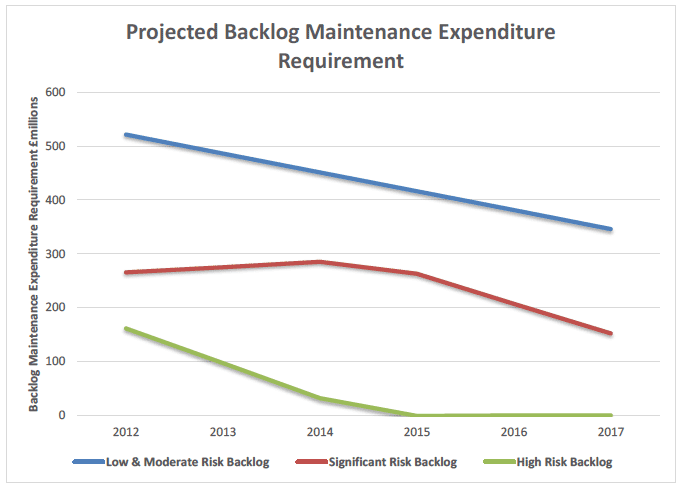
This projection indicates that high risk backlog would be largely eliminated by 2015. In addition, by 2017 significant risk backlog will be reduced from £275m to £150m and overall backlog reduced from £858m to less than £500 million. However, it should be recognised that it is very difficult to forecast changes in backlog in existing buildings.
The year on year reductions in backlog that are shown in the graph are a projection based on the following assumptions:
i. NHS Boards need to address high and significant backlog as a priority, therefore, the graph assumes that Boards will prioritise their proposals for expenditure and estate rationalisation/disposals to maximise the impact on high and significant risk backlog in the shortest practical timescale. The graph assumes that, from 2013 onwards, the maximum acceptable timescale for addressing the high risk backlog is two years, and for reducing significant risk backlog it is four years.
ii. The graph also recognises that in practice new build and refurbishment / upgrade schemes, although specifically targeted on reducing high and significant risk backlog, will inevitably also reduce low and moderate risk backlog when, for instance, this backlog is in the same building/area in which the high and significant risk backlog is present. Hence, the graph assumes that some reduction in low and moderate risk backlog will take place in parallel with the reductions in high and significant risk backlog.
iii. The net result of assumptions (i) and (ii) above is that by the end of 2015 the Boards will have had to implement all the proposals they projected in 2011 for reducing backlog i.e. £431 million reduction since 2011.
iv. The graph then assumes that by 2015 NHS Boards will have developed further proposals for addressing backlog through additional estate rationalisation and capital/revenue expenditure. This is a reasonable assumption given that NHS Boards are required to review and update their PAMS on an annual basis and historically, estate rationalisation and replacement is an ongoing and continuous feature in their PAMS. Therefore, the graph assumes that the reduction in backlog will continue beyond 2015 albeit at a slower rate than in previous years. Consequently, the graph shows that in 2016 the Boards will implement further proposals to reduce backlog by £72 million (£54 million of which is required to meet the 4 year target for reducing significant risk backlog).
v. Finally, the graph projects that by end of 2017 a total reduction in backlog of £517 million is achieved since 2011.
The graph was developed for the 2012 SAFR in order to provide NHS Boards and Scottish Government with an indication of how the 2012 backlog expenditure requirement of £948 million can expect to be addressed by Boards over the period 2012 to 2017. The SAFR reports from 2013 onwards will monitor how Boards are actually reducing their backlog maintenance.
5.1.5 Estate Performance at Hospital Level
In previous SAFR reports it was only possible to analyse estate performance at Board level, but with the ongoing development of the Estate Asset Management System (EAMS) it is now possible to report on property asset KPI's, such as backlog maintenance and physical condition, at hospital level. Analysis of this information enables identification of hospitals with the highest backlog maintenance cost and the largest area of accommodation categorised as either C or D for the facet of physical condition. This enables comparisons to be made between these hospital level indicators and highlight the strategic plans for improvement included within the appropriate NHS Board's PAMS. The results of this analysis and the strategic plans for improvement can be found in the following two tables:
The following table lists the 10 NHSScotland hospitals with the highest total cost for backlog maintenance, which naturally focuses on larger accommodation types. The total cost associated with these properties of £360m accounts for 42% of the overall backlog maintenance cost for NHSScotland; with half of this £360m attributable to significant and high risk backlog. Prioritisation of investment on these properties would make a significant contribution to reducing NHSScotland's backlog maintenance burden.
| 10 Hospitals with the highest Backlog Maintenance - Total Cost |
|||
|---|---|---|---|
| NHS Board |
Property |
Total Backlog Cost |
Strategic Plan (identified from the Board's PAMS) |
| NHS Grampian |
Aberdeen Royal Infirmary |
£60.27m |
Targeted programme of investment in backlog maintenance, focussed on inpatient accommodation |
| NHS Tayside |
Ninewells Hospital |
£44.53m |
Part of general backlog maintenance programme |
| NHS Lothian |
Western General, Edinburgh |
£39.95m |
Infrastructure investment planned with particular focus on steam plant, roof replacement and lift upgrades. |
| NHS Dumfries & Galloway |
Dumfries & Galloway Hospital |
£39.0m |
Planned replacement of hospital and estate rationalisation between 2015/16 - 2018/19 |
| NHS Lanarkshire |
Monklands Hospital |
£38.6m |
Prioritised backlog investment programme in place |
| NHS Ayrshire & Arran |
Crosshouse Hospital |
£30.86m |
Phased service developments over next 5 years to 'front door services' & new Combined Assessment Unit, plus ongoing direct backlog investment |
| NHS Greater Glasgow & Clyde |
Glasgow Royal Hospital |
£29.96m |
Part of general backlog maintenance programme |
| NHS Lothian |
Royal Edinburgh Hospital |
£28.64m |
Phased redevelopment of site from 2014 onwards |
| NHS Fife |
Victoria Hospital, Kirkcaldy |
£28.42m |
Service development works between 2013 - 2015 |
| NHS Greater Glasgow & Clyde |
Southern General Hospital |
£20.26m |
Major site redevelopment and replacement scheduled for completion in 2015 |
| TOTAL BACKLOG: |
£360m |
||
The following table lists the 10 NHSScotland hospitals with the largest overall area categorised as either C or D for the facet of Physical Condition. The total area of 398,761 sq.m. represents 28% of NHSScotland's overall estate.
Prioritisation of investment on these properties would, therefore, make a significant contribution towards improving the physical condition of NHSScotland's overall estate.
| 10 Hospitals with largest floor area categorised as either C or D for the facet of Physical Condition |
||||
|---|---|---|---|---|
| NHS Board |
Property |
KPI: Percentage in C or D |
Floor Area (sq.m) in C or D |
Strategic Plan (identified from the Board's PAMS) |
| NHS Ayrshire & Arran |
Ayrshire Central Hospital |
68% |
22,929 |
Planned replacement (circa 2015/16) with new integrated mental health facility and community hospital facility |
| NHS Fife |
Stratheden Hospital |
65% |
20,740 |
Accommodation review in 2013/14 and new IPCU in 2014/15 |
| NHS Greater Glasgow & Clyde |
Glasgow Royal Infirmary |
14% |
23,640 |
Part of general backlog maintenance programme |
| NHS Greater Glasgow & Clyde |
Gartnavel General Hospital |
80% |
52,200 |
Part of general backlog maintenance programme |
| NHS Lanarkshire |
Monklands Hospital |
77% |
40,190 |
Backlog investment programme in place |
| NHS Grampian |
Aberdeen Royal Infirmary |
67% |
80,466 |
Backlog investment programme in place |
| NHS Grampian |
Royal Cornhill Hospital |
42% |
20,559 |
Plans to rationalise surplus properties on site in 2014/15 & 2015/16 |
| NHS Lothian |
Western General Hospital |
57% |
61,235 |
Infrastructure investment planned with particular focus on steam plant, roof replacement and lift upgrades. |
| NHS Lothian |
Royal Edinburgh Hospital |
90% |
45,262 |
Phased redevelopment of site from 2014 onwards |
| NHS Dumfries & Galloway |
Dumfries & Galloway Hospital |
66% |
31,540 |
Planned replacement of hospital and estate rationalisation between 2015/16 - 2018/19 |
| TOTAL AREA: |
398,761 |
|||
5.1.6 Asset Performance Framework for Office Accommodation
The Asset Performance Framework for Office Accommodation provides similar targets to those reported above for the overall estate improvement in asset performance by 2020 and currently uses 9 key performance indicators to monitor year on year progress towards the achievement of these targets. It is anticipated that further KPI's will be developed for occupancy costs for office accommodation once more detailed and consistent financial information is available across all Boards. The Office Performance Framework for 2013 is shown below:
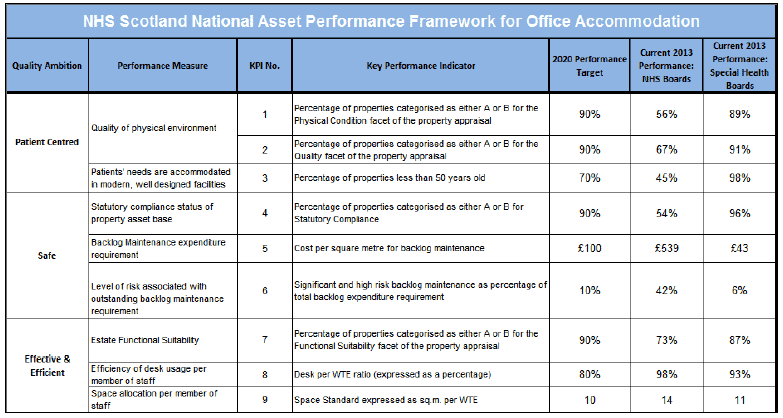
The comparison of current performance in office accommodation shows a clear distinction between NHS Boards and Special Health Boards. The analysis of tenure (outlined earlier) provides some indication of the reasons for this, with Special Health Boards tending to utilise modern leased accommodation whereas NHS Boards tending to utilise older parts of their estate, often converting properties no longer suitable for direct provision of healthcare services.
These performance results indicate an opportunity for further comparison and analysis to better understand the benefits, or otherwise, between the utilisation of existing estate that would otherwise become redundant, against the leasing of modern, purpose designed commercial accommodation.
The financial consequences of these models would also need to consider the impact on property occupancy costs as well as operational efficiency savings.
A short life working group is to be set up, supported by Scottish Futures Trust, aimed at supporting NHS Boards to develop improvement strategies for their office based accommodation. The outcome of this is expected within their 2014 PAMS.
5.2 Property and Asset Management Strategies (PAMS)
The Performance Framework includes an overall score for PAMS quality (KPI No 5). This results from a detailed review of each Board's PAMS. It is important that Boards are able to describe, in a consistent way, how well the totality of their existing property and assets is performing against ongoing policy objectives both now and in the longer term. A Property and Asset Management Strategy (PAMS) is the key strategic document for demonstrating how each NHS Board is performing in meeting this requirement.
The Scottish Government's "Policy for Property and Asset Management in NHSScotland" requires all NHSScotland bodies to have a Property and Asset Management Strategy which is reviewed and approved annually by its Board. Health Facilities Scotland has provided comprehensive guidance and training to support Boards in developing their PAMS.
One of the key aims for a PAMS is that as it is implemented it will fuel continuous improvement in the condition and performance of the asset base in supporting the delivery of healthcare services. The State of NHSScotland's Assets and Facilities Report provides an opportunity to review and compare each Board's PAMS.
5.2.1 Review of PAMS submitted in 2013
The PAMS that were submitted in March 2013 show that the main focus over the next few years is to complete the current major investments plans and then to refocus on reducing backlog and improving the utilisation of existing property assets. This should result in substantial improvement in overall property performance of the estate. Generally, the PAMS show that Boards are increasingly linking their PAMS with service strategies - an essential requirement if investment in assets is to support the delivery of the Scottish Government's vision for the future.
A review of the quality and comprehensiveness of each submitted PAMS was carried out using the PAMS checklist introduced in the 2011 State of the Estate Report and the results from this are shown overleaf. This checklist is based on the Scottish Government's "Policy for Property and Asset Management" and the Health Facilities Scotland guidance for developing a PAMS. Whilst there has been improvement in a number of PAMS, there remains potential for further improvement. Currently, there is considerable variation in PAMS quality across Boards. The Scottish Government and Health Facilities Scotland have recently provided extensive feedback to Boards on their 2013 PAMS through individual Board reports and interviews. This feedback was aimed at supporting Boards to improve their PAMS for next year.
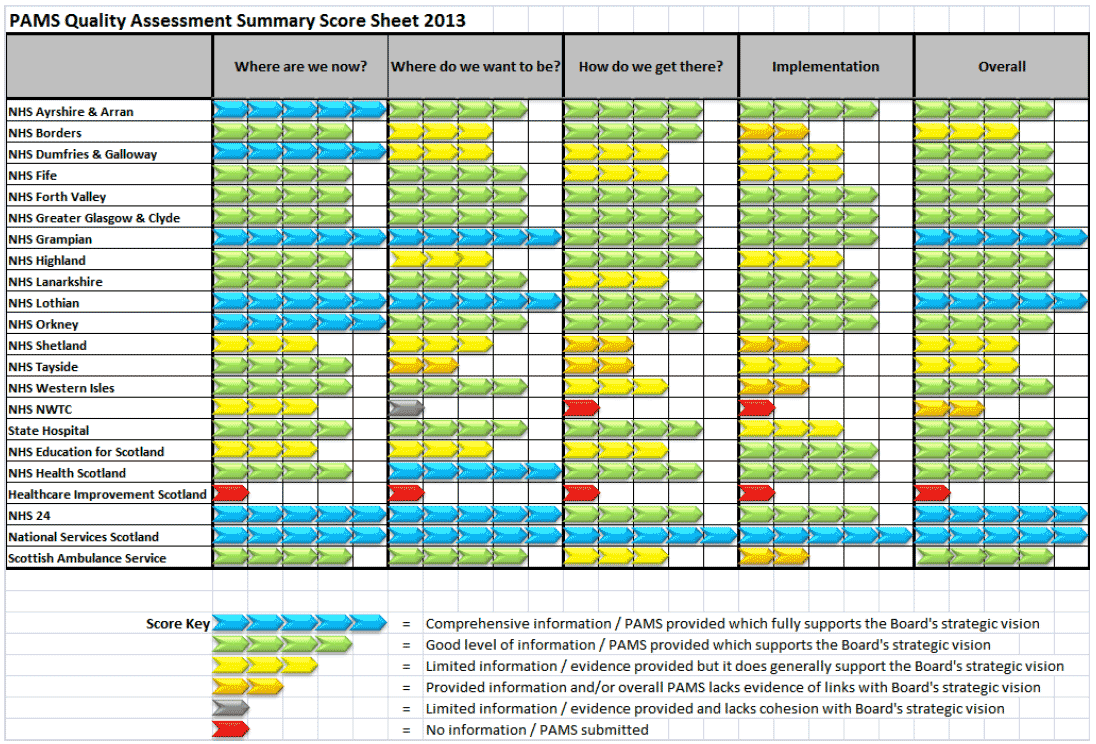
Note: NHS NWTC's PAMS is in early stages of development, with a more substantive document expected for 2014. Health Improvement Scotland did not submit a PAMS for 2013 but did so in 2012.
Contact
Email: Gillian McCallum
There is a problem
Thanks for your feedback